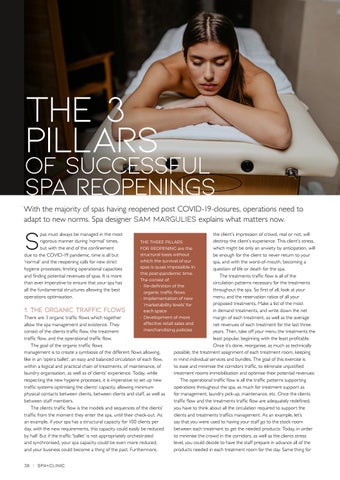The 3 Pillars
Of Successful Spa Reopenings With the majority of spas having reopened post COVID-19-closures, operations need to adapt to new norms. Spa designer Sam Margulies explains what matters now.
S
pas must always be managed in the most rigorous manner during ‘normal’ times, but with the end of the confinement due to the COVID-19 pandemic, time is all but ‘normal’ and the reopening calls for new strict hygiene processes, limiting operational capacities and finding potential revenues of spas. It is more than ever imperative to ensure that your spa has all the fundamental structures allowing the best operations optimisation.
1. THE ORGANIC TRAFFIC FLOWS
There are 3 organic traffic flows which together allow the spa management and existence. They consist of the clients traffic flow, the treatment traffic flow, and the operational traffic flow. The goal of the organic traffic flows management is to create a symbiosis of the different flows allowing, like in an ‘opera ballet’, an easy and balanced circulation of each flow, within a logical and practical chain of treatments, of maintenance, of laundry organisation, as well as of clients’ experience. Today, while respecting the new hygiene processes, it is imperative to set up new traffic systems optimising the clients’ capacity, allowing minimum physical contacts between clients, between clients and staff, as well as between staff members. The clients traffic flow is the models and sequences of the clients’ traffic from the moment they enter the spa, until their check-out. As an example, if your spa has a structural capacity for 100 clients per day, with the new requirements, this capacity could easily be reduced by half. But if the traffic ‘ballet’ is not appropriately orchestrated and synchronised, your spa capacity could be even more reduced, and your business could become a thing of the past. Furthermore, 38 | SPA+CLINIC
the client’s impression of crowd, real or not, will destroy the client’s experience. This client’s stress, which might be only an anxiety by anticipation, will be enough for the client to never return to your spa, and with the word-of-mouth, becoming a question of life or death for the spa. The treatments traffic flow is all of the circulation patterns necessary for the treatments throughout the spa. So first of all, look at your menu, and the reservation ratios of all your proposed treatments. Make a list of the most in demand treatments, and write down the net margin of each treatment, as well as the average net revenues of each treatment for the last three years. Then, take off your menu the treatments the least popular, beginning with the least profitable. Once it’s done, reorganise, as much as technically possible, the treatment assignment of each treatment room, keeping in mind individual services and bundles. The goal of this exercise is to ease and minimise the corridors traffic, to eliminate unjustified treatment rooms immobilisation and optimise their potential revenues. The operational traffic flow is all the traffic patterns supporting operations throughout the spa, as much for treatment support as for management, laundry pick-up, maintenance, etc. Once the clients traffic flow and the treatments traffic flow are adequately redefined, you have to think about all the circulation required to support the clients and treatments traffics management. As an example, let’s say that you were used to having your staff go to the stock room between each treatment to get the needed products: Today, in order to minimise the crowd in the corridors, as well as the clients stress level, you could decide to have the staff prepare in advance all of the products needed in each treatment room for the day. Same thing for
THE THREE PILLARS FOR REOPENING are the structural basis without which the survival of our spas is quasi impossible in this post-pandemic time. The consist of: • Re-definition of the organic traffic flows • I mplementation of new ‘marketability levels’ for each space • Development of more effective retail sales and merchandising policies
